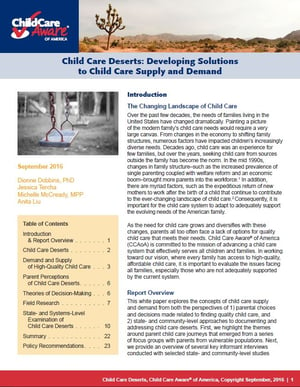 You might be wondering, “What is a Child Care Desert?”. Just as food deserts — urban areas where it’s difficult to buy affordable, fresh food — can have an adverse impact on nutrition, “child care deserts” identifies an absence of an essential commodity to support the workforce that results in limited access, which current child care systems do not meet.
You might be wondering, “What is a Child Care Desert?”. Just as food deserts — urban areas where it’s difficult to buy affordable, fresh food — can have an adverse impact on nutrition, “child care deserts” identifies an absence of an essential commodity to support the workforce that results in limited access, which current child care systems do not meet.
Eleven million children younger than age five are in some form of child care in the United States, and there is a growing need for quality child care.
With the passage of the Child Care and Development Block Grant Act of 2014, it is paramount that states and communities understand how to study child care supply and demand, analyze their findings, identify areas of child care deserts, and implement policy solutions that ensure parents have access to quality child care. At the local and state levels, child care leaders (especially CCR&Rs) have traditionally examined child care access, conducted needs assessments, and mapped supply and demand for target populations. Child Care Aware® of America (CCAoA) is committed to the mission of advancing a child care system that effectively serves all children and families. In working toward our vision, where every family has access to high-quality, affordable child care, it is important to evaluate the issues facing all families, especially those who are not adequately supported by the current system.
Child Care Aware® of America is pleased to present the Child Care Deserts: Developing Solutions to Child Care Supply and Demand report, which addresses these issues. The report introduces the concept of child care deserts broadly—focusing on both parent perceptions of their child care journeys and the ways in which communities across seven states have started to examine supply and demand concerns. It’s our first foray into this area, and we look forward to refining the definition as we continue our exploration. Nevertheless, we’ve learned some important things from focus groups with parents seeking child care and interviews with key child care leaders across the country.
Parents who participated in our focus groups talked about their child care journeys, describing how they identified and later selected their child care provider(s). Although parents had very different situations from one another, we learned the following from parent focus group participants:
- There’s an increasing gap between supply of and demand for quality, affordable child care;
- Parents make accommodations, not choices when it comes to child care, weighing a program’s perceived quality with its actual cost;
- Relationships between parents and providers that are based on trust and good communication are integral to parents’ satisfaction with their provider; and
- Locating and selecting a child care program can be difficult and frustrating for many parents.
As we delved deeper into the issue of child care deserts, we interviewed researchers from seven communities exploring child care supply and demand in their states or regions. From our interviews, we found that child care deserts are especially prevalent in low-income communities, rural communities, among families of color, and among families with irregular or non-traditional work schedules. Organizations had a lot of recommendations for others beginning their studies on supply and demand. They recommended that other researchers always keep their audience in mind when collecting data and reporting it, and that they be careful to maintain clean, consistent data. They also suggested that collaborating with key stakeholders, leveraging area resources, and learning from work others have done are ways to make the most out of a study on area supply and demand.
Based on these findings, we recommend that legislators at the state and federal level:
- Increase funding and resources to child care providers and networks,
- Invest in the child care industry’s infrastructure,
- Adequately support the child care workforce, and
- Strengthen community capacity building.
Additional information, resources, and the full Child Care Deserts: Developing Solutions to Child Care Supply and Demand report can be found at usa.childcareaware.org/childcaredeserts.





